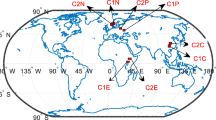Abstract
Flood quantiles are routinely used in hydrologic engineering to design hydraulic structures, optimize erosion control structure and map the extent of floodplains. As an increasing number of papers are pointing out cycles and trends in hydrologic time series, the use of stationary flood distributions leads to the overestimation or underestimation of the hydrologic risk at a given time. Several authors tried to address this problem by using probability distributions with time-varying parameters. The parameters of these distributions were assumed to follow a linear or quadratic trend in time, which may be valid for the short term but may lead to unrealistic long-term projections. On the other hand, deterministic rainfall-runoff models are able to successfully reproduce trends and cycles in stream flow data but can perform poorly in reproducing daily flows and flood peaks. Rainfall-runoff models typically have a better performance when simulation results are aggregated at a larger time scale (e.g. at a monthly time scale vs. at a daily time scale). The strengths of these two approaches are combined in this paper where the annual maximum of the time-averaged outputs of a hydrologic model are used to modulate the parameters of a non-stationary GEV model of the daily maximum flow. The method was applied to the Kemptville Creek located in Ontario, Canada, using the SWAT (Soil and Water Assessment Tool) model as rainfall-runoff model. The parameters of the non-stationary GEV model are then estimated using Monte Carlo Markov Chain, and the optimal span of the time windows over which the SWAT outputs were averaged was selected using Bayes factors. Results show that using the non-stationary GEV distribution with a location parameter linked to the maximum 9-day average flow provides a much better estimation of flood quantiles than applying a stationary frequency analysis to the simulated peak flows.






Similar content being viewed by others
References
Adamowski K (2000) Regional analysis of annual maximum and partial duration flood data by nonparametric and L-moment methods. J Hydrol 229:219–231
Cunderlik JM, Burn DH (2003) Non-stationary pooled flood frequency analysis. J Hydrol 276:210–223
Cunderlik JM, Ouarda TBMJ (2006) Regional flood-duration-frequency modeling in a changing environment. J Hydrol 318:276–291. doi:10.1016/j.jhydrol.2005.06.020
Douglas EM, Vogel RM, Kroll CN (2000) Trends in floods and low flows in the United States: impact of spatial correlation. J Hydrol 240:90–105
Dunne T, Leopold LB (1978) Calculation of flood hazard. In Dunne T, Leopold LB (eds) Water in environmental planning. WH Freeman and Co, San Francisco, pp 279–391
El Adlouni S, Favre AC, Bobee B (2006) Comparison of methodologies to assess the convergence of Markov chain Monte Carlo methods. Comput Stat Data Anal 50:2685–2701
El Adlouni S, Ouarda TBMJ, Zhang X, Roy R, Bobée B (2007) Generalized maximum likelihood estimators for the nonstationary generalized extreme value model. Water Resour Res 43(W03410). doi:10.1029/2005WR004545
Geweke J (1992) Evaluating the accuracy of sampling-based approaches to the calculation of posterior moments, Bayesian Statistics 4. In JM Bernardo, JO Berger, AP David, AFM Smith (eds) Oxford University Press, Oxford, pp 169–193
GREHYS (1996) Presentation and review of some methods for regional flood frequency analysis. J Hydrol 186:63–84
Gumbel EJ (1958) Statistics of extremes. Columbia University Press, New York
IPCC (2007) Climate change 2007: impacts, adaptation, and vulnerability. Cambridge University Press, Cambridge
Leadbetter MR, Lindgren G, Rootzen H (1983) Extremes and related properties of random sequences and processes. Springer, New York
Leclerc M, Ouarda TBMJ (2007) Non-stationary regional flood frequency analysis at ungauged sites. J Hydrol 343:254–265
Min SK, Hense A (2006) A Bayesian approach to climate model evaluation and multi-model averaging with an application to global mean surface temperatures from IPCC AR4 coupled climate models. Geophys Res Lett 33:L08 708. doi:10.1029/2006GL025779
Nam DH, Udo K, Mano A (2009) Examination of flood runoff reproductivity for different rainfall sources in central Vietnam, world academy of science. Eng Technol 59:103–108
Newton MA, Raftery AE (1994) Approximate Bayesian inference with the weighted likelihood bootstrap. J Roy Stat Soc Ser B 56:3–48
Seidou O, Ouarda TBMJ, Barbet M, Bruneau P, et Bobée BA (2006) Bayesian combination of local et regional information in flood frequency analyses. Water Resour Res 42(W11408):1–21. doi:10.1029/2005WR004397
Singh VP, Strupczewski WG (2002) On the status of flood frequency analysis. Hydrol Process 16:3737–3740
Stephenson AG (2002) A user guide to the evdbayes package. (version I. 0). http://cran.r-project.org
United Nations University (2010) The Waterbase Project. http://www.waterbase.org
Author information
Authors and Affiliations
Corresponding author
Rights and permissions
About this article
Cite this article
Seidou, O., Ramsay, A. & Nistor, I. Climate change impacts on extreme floods I: combining imperfect deterministic simulations and non-stationary frequency analysis. Nat Hazards 61, 647–659 (2012). https://doi.org/10.1007/s11069-011-0052-x
Received:
Accepted:
Published:
Issue Date:
DOI: https://doi.org/10.1007/s11069-011-0052-x




